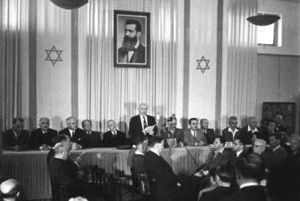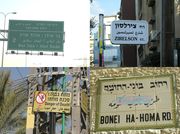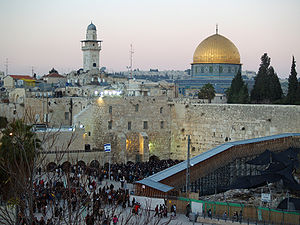Israelis
| Row 1: Ada Yonath • Robert Aumann • Natalie Portman • Amos Oz • Yossi Benayoun • Shahar Pe'er Row 2: Moshe Dayan • David Ben-Gurion • Yitzhak Rabin • Menachem Begin • Golda Meir • Ariel Sharon |
||||||||||||
| Regions with significant populations | ||||||||||||
|---|---|---|---|---|---|---|---|---|---|---|---|---|
|
||||||||||||
| Languages | ||||||||||||
| Predominant spoken languages Hebrew, Arabic, English, Russian |
||||||||||||
| Religion | ||||||||||||
| Predominantly Judaism (minorities practicing Islam, Christianity, Druzism) |
Israelis (Hebrew: ישראלים, Israelim), are citizens or nationals of the modern state of Israel. Although Israel is considered a Jewish state, it is a multi-ethnic nation, home to people of different ethnic and national backgrounds, most numerously Jews, as well as smaller populations of Muslims, Christians, Arabs, Druze, Circassians, and others. As a result, some Israelis don't take their nationality as an ethnicity, but identify themselves with both their nationality and their ancestral origins.
Due to the multi-ethnic composition, Israel is a multicultural nation, home to a wide variety of traditions and values. Large-scale immigration in the late nineteenth and early twentieth centuries from Europe and more recent Large-scale immigration North Africa, Western Asia, North America, Former Soviet Union and Ethiopia introduced many new cultural elements and has had broad impact. The resulting cultural mix may be described as a homogeneous melting pot.
In addition to Israel, Israelis and people of Israeli descent can be found internationally such as in the United States, Canada, UK and throughout Europe. As many as 750,000 Israelis are estimated to be living abroad, primarily in the United States and Canada - about 12.5 percent of the general Jewish population of Israel.[5]
Contents |
Population
According to Israel's Central Bureau of Statistics, as of May 2006, of Israel's 7 million people, 77% were Jews of any background, 18.5% non-Jewish Arabs, and 4.3% "others".[6] Among Jews, 68% were Sabras (Israeli-born), mostly second- or third-generation Israelis, and the rest are olim (Jewish immigrants to Israel) — 22% from Europe and the Americas, and 10% from Asia and Africa, including the Arab countries.[7] Nearly half of all Israeli Jews are descended from Jews who immigrated from Europe, while around the same number are descended from Jews who immigrated from Arab countries, Iran, Turkey and Central Asia. Over two hundred thousand are, or are descended from, Ethiopian and Indian Jews.[8]
Israel has two official languages; Hebrew and Arabic. Hebrew is the major and primary language of the state and is spoken by the majority of the population. Arabic is spoken by the Arab minority and by some members of the Mizrahi Jewish community. English is studied in school and is spoken by the majority of the population as a second language. Other languages spoken in Israel include Russian, Yiddish, Ladino, Amharic, Romanian, Polish and French. American and European popular television shows are commonly presented. Newspapers can be found in all languages listed above as well as others, such as Persian.
In recent decades, considerable numbers of Israelis, estimated broadly from 653,000[9] to twice that figure, have moved abroad.[10] (see also Yerida). Reasons for emigration vary, but generally relate to a combination of economic and political concerns. Los Angeles is home to the largest community of Israelis out of Israel.
Ethnic and religious groups
The most prominent ethnic and religious groups, whom currently live in the Israel and whom are Israeli citizens or nationals, is as follows:
Jews
According to Israel's Central Bureau of Statistics, as of 2009, of Israel's 7 million people, 75.47% were Jews of any background.[1] Among them, 68% were Sabras (Israeli-born), mostly second- or third-generation Israelis, and the rest are olim (Jewish immigrants to Israel) — 22% from Europe and the Americas, and 10% from Asia and Africa, including the Arab countries.[7]
Nearly half of all Israeli Jews are descended from Jews who immigrated from Europe, while around the same number are descended from Jews who immigrated from Arab countries, Iran, Turkey and Central Asia. Over two hundred thousand are, or are descended from, Ethiopian and Indian Jews.[8]
Arabs
Arab citizens of Israel are those Arabs who remained within Israel's borders during the 1948 Palestinian exodus following the establishment of the state of Israel, including those born within the state borders subsequent to this time, as well as those who had left during the exodus (or their descendants) who have since re-entered by means accepted as lawful residence by the Israeli state (primarily family reunifications).
this figure include 209,000 Arabs (14% of the Israeli-Arab population) in east Jerusalem, also counted in the Palestinian statistics , although 98% of East Jerusalem Palestinians has either Israeli residency or Israeli citizenship.[11]
Most Arab citizens of Israel are Muslim, particularly of the Sunni branch of Islam, and there is a significant Arab Christian minority from various denominations, as well as Arab Druze, among other religious communities.
As of 2008, Arab citizens of Israel comprise just over 20% of the country's total population. About 82.6% of the Arab population in Israel is Sunni Muslim (with a very small minority of Shia), another 9% is Druze, and around 9% is Christian (mostly Eastern Orthodox and Catholic denominations).
The Arab citizens of Israel include also the Bedouins who are divided into two main groups: the Bedouin in the north of Israel, who live in villages and towns for the most part, and the Bedouin in the Negev, who include half-nomadic and inhabitants of towns and Unrecognized villages. According to the Foreign Affairs Minister of Israel, currently, 110,000 Bedouins live in the Negev, 50,000 in the Galilee and 10,000 in the central region of Israel.[12]
The Arab citizens of Israel include also the Druze who were numbered at an estimated 117,500 at the end of 2006.[13] All of the Druze living in what was then British Mandate for Palestine became Israeli citizens after the declaration of the State of Israel. Though some individuals identify themselves as "Palestinian Druze",[14] most Druze do not consider themselves to be Palestinian, and consider their Israeli identity stronger than their Arab identity; indeed, Druze serve prominently in the Israel Defense Forces, and are represented in mainstream Israeli politics and business as well, unlike the Israeli Muslim Arabs who are not required to and choose not to serve in the Israeli army.
Non-Arab and Non-Jew citizens
African Hebrew Israelites of Jerusalem
More than 5,000 members of the spiritual group African Hebrew Israelites of Jerusalem reside in Israel mostly in their own community in Dimona, Israel while additional families live in Arad, Mitzpe Ramon, and the Tiberias area. The members of the African Hebrew Israelite Nation of Jerusalem community believe that they are descended from the Ten Lost Tribes of Israel and at least some of them consider themselves to be Jewish, but mainstream Judaism does not consider them to be Jewish.
Armenians
More than 5,000 Armenians reside in Israel mostly in Jerusalem (including in the Armenian Quarter), but also in Tel Aviv, Haifa and Jaffa. Armenians have a Patriarchate in Jerusalem and churches in Jerusalem, Bethlehem, Haifa and Jaffa.
Circassians
More than 4,000 Circassians reside in Israel, living mostly in Kfar Kama (2,900) and Reyhaniye (1,000).[15] These two villages were a part of a greater group of Circassian villages around the Golan Heights. The Circassians in Israel enjoy, like Druzes, a status aparte. Male Circassians (at their leader's request) are mandated for military service, while females are not.
Samaritans
More than 700 Samaritans reside in Israel, living mostly in Holon and Mount Gerizim in the West Bank. The Samaritans are an ethnoreligious group of the Levant. Ancestrally, they claim descent from a group of Israelite inhabitants who have connections to ancient Samaria from the beginning of the Babylonian Exile up to the beginning of the Common Era.
Others
Smaller prominent ethnic and religious groups, whom currently live in the Israel and whom are Israeli citizens or nationals, include:
- Non-Jewish immigrants from the former Soviet Union whom were eligible to immigrate due to having, or being related to somebody who has, at least one Jewish grandparent.
Israeli diaspora
Through the years, the majority of Israelis who emigrated from Israel went to the United States, Canada and the United Kingdom.
For many years definitive data on Israeli emigration was unavailable.[16] In The Israeli Diaspora sociologist Stephen J. Gold maintains that calculation of Jewish emigration has been a contentious issue, explaining, "Since Zionism, the philosophy that underlies the existence of the Jewish state, calls for return home of the world's Jews, the opposite movement - Israelis leaving the Jewish state to reside elsewhere - clearly presents an ideological and demographic problem."[17]
Among the most common reasons for emigration of Israelis from Israel are most often due to economic constraints, economic characteristics (U.S. and Canada have always been richer nations than Israel), disappointment of the Israeli government, Israel's ongoing security Issues, as well as the excessive role of religion in the lives of Israelis.
United States of America
Many Israelis emigrated to the United States throughout the period of the declaration of the state of Israel and until today. Today, the descendants of these people are known as Israeli-Americans. According to the 2000 United States Census as many as 106,839 Israelis lived in the United States in 2000.[1]
Canada
Many Israelis emigrated to the Canada throughout the period of the declaration of the state of Israel and until today. Today, the descendants of these people are known as Israeli-Canadians. According to the Canada 2006 Census as many as 21,320 Israelis lived in the Canada in 2006.[3]
United Kingdom
Many Israelis emigrated to the United Kingdom throughout and since the period of the declaration of the state of Israel. Today, the descendants of these people are known as Israeli-British. According to the United Kingdom 2001 Census as many as 11,892 Israelis lived in the United Kingdom in 2001. The majority of Israelis in the UK live in London.[18]
History

The Palestinian territory, which would one day become the State of Israel, was hewed out of the Ottoman Empire by Zionism and the British Mandate. The British establishment of colonial political boundaries allowed the Jews to develop autonomous institutions such as the Histadrut and the Knesset.[19]
During the 1930s the Zionist movement began to encourage Jewish immigration to Palestine. The resulting influx of Jewish immigrants was crucial for the functioning of these new institutions in what would, on May 14, 1948, become the State of Israel.[20]
Culture
The largest cities in the country Haifa, Tel Aviv, and Jerusalem are also the major cultural centers, known for art museums, and many towns and kibbutzim have smaller high-quality museums. Israeli music is very versatile and combines elements of both western and eastern, religious and secular music. It tends to be very eclectic and contains a wide variety of influences from the Diaspora and more modern cultural importation: Hassidic songs, Asian and Arab pop, especially by Yemenite singers, and Israeli hip hop or heavy metal. Folk dancing, which draws upon the cultural heritage of many immigrant groups, is popular. There is also flourishing modern dance.
Religion in Israel
According to Israel's Central Bureau of Statistics, at the end of 2004, 76.2% of Israelis were Jewish by religion (Judaism), 16.1% were Muslims, 2.1% Christian, 1.6% Druze and the remaining 3.9% (including Russian immigrants and some ethnic Jews) were not classified by religion.[6]
Roughly 12% of Israeli Jews defined as haredim (ultra-orthodox religious); an additional 9% are "religious"; 35% consider themselves "traditionalists" (not strictly adhering to Jewish Halakha); and 43% are "secular" (termed "hiloni"). Among the seculars, 53% believe in God. However, 78% of all Israelis (and virtually all Israeli Jews) participate in a Passover seder.[21]
Unlike North American Jews, Israelis tend not to align themselves with a movement of Judaism (such as Reform Judaism or Conservative Judaism) but instead tend to define their religious affiliation by degree of their religious practice.
Among Arab Israelis, 82.6% were Muslim, 8.8% were Christian and 8.4% were Druze.[6]
The Bahá'í World Centre, which includes the Universal House of Justice, in Haifa attracts pilgrims from all over the world.[22] Apart from a few hundred volunteer staff, Bahá'ís do not live in Israel.
| Religion | Population | % of total |
|---|---|---|
| Jewish | 5,435,900 | 76.0% |
| Muslim | 1,142,000 | 15.9% |
| Christian | 120,000 | 1.8% |
| Druze | 115,200 | 1.7% |
| Unclassified by choice | 302,400 | 4.6% |
Official figures do not exist as to the number of atheists or otherwise non-affiliated individuals, who may comprise up to a quarter of the population referred to as Jewish. According to a 2004 Israel Central Bureau of Statistics Study on Israelis aged over 8% of Israeli Jews define themselves as haredim (or Ultra-Orthodox); an additional 9% are "religious" (predominantly orthodox, also known in Israel as: Zionist-religious, national-religious and kippot srugot); 12% consider themselves "religious-traditionalists" (mostly adhering to Jewish Halakha); 27% are "non-religious traditionalists" (only partly respecting the Jewish Halakha), and 43% are "secular". Among the seculars, 53% say they believe in God. Due to the higher natality rate of religious and traditionalists over seculars, the share of religious and traditionalists among the overall population is even higher.
Languages

Due to its immigrant nature, Israel is one of the most multicultural and multilingual societies in the world. Hebrew and Arabic are the official languages in the country, while English, Russian, Georgian, Yiddish, Romanian, Ukrainian, Amharic, Armenian, Ladino, French, Spanish, German, Vietnamese, Thai, Tagalog, Persian and Polish are the most commonly used foreign languages. A certain degree of English is spoken virtually universally, and is the language of choice for many Israeli businesses. Courses on the English language are mandatory in the Israeli school system, and most schools offer in addition either Arabic, Spanish, German or French.
See also
- Demographics of Israel
- Culture of Israel
- Modern Israeli Hebrew
Notes
- ↑ 1.0 1.1 1.2 http://www1.cbs.gov.il/www/hodaot2009n/11_09_208b.doc
- ↑ http://www.census.gov/prod/2004pubs/c2kbr-35.pdf
- ↑ 3.0 3.1 http://www40.statcan.gc.ca/l01/cst01/demo24a-eng.htm
- ↑ "Country-of-birth database". Organisation for Economic Co-operation and Development. http://www.oecd.org/dataoecd/18/23/34792376.xls. Retrieved 2008-12-23.
- ↑ Eric, Gold; Moav, Omer (2006) (in Hebrew), Brain Drain From Israel (Brichat Mochot M'Yisrael), Jerusalem: Mercaz Shalem - The Shalem Center, The Social-Economic Institute, pp. 26, http://www.knesset.gov.il/committees/heb/material/data/mada2006-06-28.doc.
- ↑ 6.0 6.1 6.2 Central Bureau of Statistics, Government of Israel. "Population, by religion and population group" (PDF). http://www1.cbs.gov.il/shnaton56/st02_01.pdf. Retrieved 2006-04-08.
- ↑ 7.0 7.1 Central Bureau of Statistics, Government of Israel. "Jews and others, by origin, continent of birth and period of immigration" (PDF). http://www1.cbs.gov.il/shnaton56/st02_24.pdf. Retrieved 2006-04-08.
- ↑ 8.0 8.1 http://www.cbs.gov.il/reader/shnaton/templ_shnaton.html?num_tab=st02_23x&CYear=2005
- ↑ http://cbs.gov.il/reader/newhodaot/hodaa_template.html?hodaa=200801157
- ↑ Andrew I. Killgore."Facts on the Ground: A Jewish Exodus from Israel" Washington Report on Middle East Affairs, March 2004, pp.18-20
- ↑ "Selected Statistics on Jerusalem Day 2007 (Hebrew)". Israel Central Bureau of Statistics. 2007-05-14. http://www.cbs.gov.il/hodaot2007n/11_07_084b.doc.
- ↑ The Bedouin in Israel: Demography Israel Ministry of Foreign Affairs 1999-07-01
- ↑ Table 2.2, Statistical Abstract of Israel 2007, No. 58.
- ↑ Yoav Stern & Jack Khoury (2007-05-02). "Balad's MK-to-be: 'Anti-Israelization' Conscientious Objector". Haaretz. http://www.haaretz.com/hasen/spages/854636.html. Retrieved 2007-07-29.For example, Said Nafa, a self-identified "Palestinian Druze" serves as the head of the Balad party's national council and founded the "Pact of Free Druze" in 2001, an organization that aims ";to stop the conscription of the Druze and claims the community is an inalienable part of the Arabs in Israel and the Palestinian nation at large."
- ↑ "Circassians in Israel". Circassian World. http://www.circassianworld.com/Israel.html.
- ↑ Henry Kamm. "Israeli emigration inspires anger and fear;" New York Times January 4, 1981
- ↑ Stephen J. Gold. The Israeli Diaspora; Routledge 2002, p.8
- ↑ http://www.oecd.org/dataoecd/18/23/34792376.xls
- ↑ Migdal, p. 135
- ↑ Migdal, p. 136
- ↑ Religion in Israel: A Consensus for Jewish Tradition by Daniel J. Elazar (JCPA)
- ↑ "The Bahá'í World Centre: Focal Point for a Global Community". The Bahá'í International Community. http://info.bahai.org/article-1-6-0-5.html. Retrieved 2007-07-02.
External links
- BBC News | Israel's modern immigrants
- BBC News | Israel faces Russian brain drain
- Kehilot | Secular & Religious Jewish Communities of Israel
|
||||||||||||||
